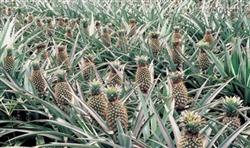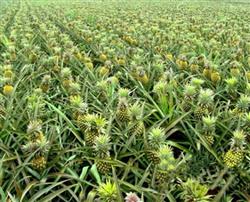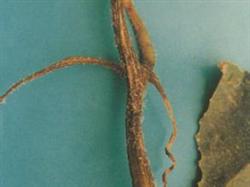Cultivation and management techniques for high yield and high quality of pineapple

First, selected and prepared pineapple is a tropical crop, which is warm, moist, soft and fertile, while afraid of frost, drought, stickiness and barren. The county has a tropical climate and is the most suitable ecological area for pineapple growth. When arranging the planting of pineapple, we should choose the land with deep, soft, moist soil and more organic matter, like slightly acidic soil, the acidity to slightly acidity of pH 5-6.5 is the most suitable, strong acidic, neutral and alkaline soil is not conducive to the growth of pineapple. Slopes should be selected and planted on open slopes below 20 degrees. Deep ploughing and shallow planting should be done when planting, and deep ploughing by tractors should be divided into two times in soil preparation: for the first time, a single pear share should be turned over 30 cm with a tractor 2-3 months before planting, so that small shrubs and weeds will die, and then rake mud masses; the second time, ploughshare should be used to plough and rake flat, so that the soil can reach the standard of deep, loose and fine. This not only makes the pineapple root deeply rooted, but also helps the root system to absorb water and fertilizer, and creates conditions for the high yield of pineapple. Second, the promotion and selection of excellent varieties 1, no thorn caine, also known as Sarawak, Hawaii, Sarawak, Italy, Qianli flower. The main characteristics of this variety are: upright and tall plant type, large fruit, weight 1.5-3 kg, long tube type, large and flat fruit eyes, shallow diced fruit (flower cavity), yellowish white flesh, soft and juicy flesh, moderate sour and sweet, it is the main variety of canning. The pericarp of this variety is thin, easy to sunburn and infected with wilt, and is not resistant to storage. Because there are no thorns in the leaves, the field management is more convenient. But it needs a lot of fertilizer and requires fine management. 2. The Bali variety originated from the Philippines, the main characteristics: medium plant growth, medium fruit, single fruit weight 0.5-1.5 kg, barrel or micro-conical, medium large fruit eyes, conical protuberances, deep diced fruit, dark yellow flesh, moderate soft and hard, moderate juice, moderate sweet and sour, sweet flavor, high quality, suitable for fresh food, and can be processed into cans. The variety has strong adaptability, drought resistance and cold resistance, high and stable yield, and is more resistant to storage. But during processing, the fruit eye is deeper, there are many gardeners, and the rate of finished products is low. 3. 57-236 varieties bred by Fruit Tree Research Institute of Guangdong Academy of Agricultural Sciences. This variety has the advantages of erect plant type, suitable for close planting, large fruit and high yield, and its ripening period is between caine and Bali. It is a dual-purpose variety for fresh food and canning, which is helpful to solve the problem of over-concentration in market and processing period. Third, proper close planting and giving full play to population advantages are important links in high and stable yield of pineapple. Pineapple planting density has a great relationship with yield. Because it is a plant that can only bear one fruit, it is more effective to increase fruit number by close planting than to increase fruit weight by sparse planting. General planting density is suitable for double-row planting of 3000-4000 seedlings per mu, with large row spacing of 110cm-130cm, small row spacing of 30-40cm and plant spacing of about 20cm. The species of Cain should be slightly thinner than those planted in Bali. According to the test results of pineapple test station in Xuwen County, the average yield per mu is 4906 kg and 4922 kg, and 6600 seedlings are planted in Bali per mu. In the high-yield field with a yield of 5260.61 kg per mu, the number of seedlings planted in Bali reached 10000 per mu. Pineapple is a shade-tolerant herbaceous fruit tree. Proper close planting can not only improve the utilization of light energy, but also improve the natural microclimate, form self-shade environmental conditions, reduce soil water evaporation, avoid Rain Water erosion, and improve soil water and fertilizer conservation capacity. it is beneficial to the growth of pineapple. Although the proportion of large fruits decreased after close planting, due to the significant increase in yield per unit area, the absolute amount of primary and secondary fruits was still higher than that of sparse planting. Fourth, classification and classification selection of excellent seedlings when planting pineapple, we should make a good classification and classification selection of seedlings according to local conditions. Fertile selection of Cain species, poor areas to choose Balinese species. The seedlings of the same type can be divided into big and small strong and weak. If they are not graded by manual selection and mixed planting, the phenomena of high, short, large, small, strong and weak will often appear in the same field. In the process of growth, the big seedlings cover the small seedlings, affecting the seedlings to absorb sunlight, rain, dew and nutrients, and grow slowly. Therefore, before planting, the different types of buds of the same variety should be classified and graded, and the big and small strong and weak seedlings should be divided into blocks, so that their growth is balanced, the buds are neat, and the results are consistent.
- Prev

Practical cultivation techniques of pineapple
Pineapple, also known as pineapple, English name Pineapple, belongs to the pineapple family, pineapple genus, is a perennial monocotyledonous herb, growing on the ground, the fruit is an aggregate fruit formed by the aggregation of most small fruits, generally weighing 1Mel 1.5kg. Pineapple is a tropical fruit, native to Central and South America, pineapple fruit is nutritious, fruit juice is not.
- Next

Opinions on production management of cantaloupe in greenhouse at present
This is cantaloupe suffering from a typical vine blight or muskmelon black rot. In general, the initial symptoms are mostly in the vine joint, and there are light yellowish-green oil stains, and the disease often secretes russet colloid, which becomes a dark brown mass after drying. In the later stage, the disease spot is dry and sunken, and the surface is pale and fragile. Prevention and control methods: 1, cultivation.
Related
- Moge, come on! The staff of the peasant association in the producing area of cantaloupe were frightened when the crowd gathered.
- Causes and Solutions of low Fruit setting rate of Apple
- Symptoms and control measures of passion fruit virus disease
- Fruit growing lesson: how do apple orchards keep high yields?
- Can you build orchards in the mountains? What are the pros and cons?
- How to manage the coloring period of Crisson grape?
- This paper introduces the processing technology of two kinds of fig products.
- How much is a month for retired teachers in rural areas by 2020?
- How can strawberry planting increase sugar content? We should pay attention to management in many aspects.
- What are the cultivation techniques on how to improve the yield of golden fruit?

